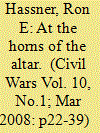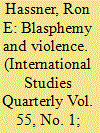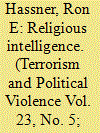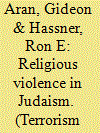|
|
|
Sort Order |
|
|
|
Items / Page
|
|
|
|
|
|
|
| Srl | Item |
| 1 |
ID:
080775


|
|
|
|
|
| Publication |
2008.
|
| Summary/Abstract |
This paper examines the origins and development of the sanctuary practice in Judaism, Christianity and Islam. The customs and laws relating to the sanctuary practice underwent a process of institutionalization that exemplified a constant tension between religious authorities, who wished to expand the practice, and secular authorities, who wished to eliminate it. This struggle resulted in an accommodation: the adoption of rules that restrict the practice in space, scope and duration. Contemporary leaders can draw on these rules to confront the challenges posed by insurgents who appeal for the right of sanctuary. Specifically, secular leaders can rely on these rules to reduce the insurgents' freedom of movement, to demand the expulsion of insurgents from sacred sites, and to attempt the peaceful resolution of standoffs with insurgents who seek prolonged refuge in sacred sites.
|
|
|
|
|
|
|
|
|
|
|
|
|
|
|
|
| 2 |
ID:
140920


|
|
|
|
|
| Summary/Abstract |
Fortified boundaries are asymmetrical, physical barriers placed along borders. These boundaries are more formidable in structure than conventional boundary lines, but less robust than militarized boundaries. Their goal is to impose costs on infiltrators and in so doing deter or impede infiltration. A novel dataset of all such boundaries worldwide shows that states are constructing these barriers at an accelerating rate. More than half of barrier builders are Muslim-majority states, and so are the vast majority of targets. A multivariate analysis demonstrates that, contrary to conventional wisdom, states that construct such barriers do not tend to suffer disproportionately from terrorism, nor are they apt to be involved in a significant number of territorial disputes. Instead, differences in state wealth and migration rates are the best predictors of barrier construction. Qualitative case studies suggest that the most effective fortified boundaries are found where the initiating state controls the territory beyond a boundary that blocks the only access route into the state.
|
|
|
|
|
|
|
|
|
|
|
|
|
|
|
|
| 3 |
ID:
103302


|
|
|
|
|
| Publication |
2011.
|
| Summary/Abstract |
Why did riots in response to the 2005 Danish cartoons depicting the Prophet Muhammad occur in nine Muslim states but not in 43 other states in which Muslims form a majority of the population? I show that the location of the cartoon riots is best explained by combining insights from the study of politics with arguments from the sociology of religion. Protests were mobilized by radical Islamist movements alarmed by the moral threat posed by the blasphemous cartoons. In states characterized by political rights and civil liberties, regimes responded haphazardly to the demonstrations, leading to confrontations between security forces and angry rioters. This finding can be generalized beyond the Muslim world: We should expect reactive religious violence wherever fundamentalist movements are confronted by transgressive acts, committed by threatening opponents, in a political environment that permits protest but fails to protect the religious principles of the movement.
|
|
|
|
|
|
|
|
|
|
|
|
|
|
|
|
| 4 |
ID:
173430


|
|
|
|
|
| Summary/Abstract |
Empirical evidence on contemporary torture is sparse. The archives of the Spanish Inquisition provide a detailed historical source of quantitative and qualitative information about interrogational torture. The inquisition tortured brutally and systematically, willing to torment all who it deemed as withholding evidence. This torture yielded information that was often reliable: witnesses in the torture chamber and witnesses that were not tortured provided corresponding information about collaborators, locations, events, and practices. Nonetheless, inquisitors treated the results of interrogations in the torture chamber with skepticism. This bureaucratized torture stands in stark contrast to the “ticking bomb” philosophy that has motivated US torture policy in the aftermath of 9/11. Evidence from the archives of the Spanish Inquisition suggests torture affords no middle ground: one cannot improvise quick, amateurish, and half-hearted torture sessions, motivated by anger and fear, and hope to extract reliable intelligence.
|
|
|
|
|
|
|
|
|
|
|
|
|
|
|
|
| 5 |
ID:
068915


|
|
|
| 6 |
ID:
146243


|
|
|
|
|
| Summary/Abstract |
Recent U.S. military engagements in the Middle East have drawn public attention to the thorny issue of religion in the armed forces but the scholarship on religion in the military lags far behind these developments. Scholars have not developed a coherent research program around the challenges that religion faces in the armed forces or the religious issues that soldiers, commanders and military institutions grapple with on a daily basis. This papers seeks to initiate a scholarly conversations about the roles and effects of religion in the armed forces. I propose exploratory hypotheses that touch on some key themes that such a research program might cover, at three levels of analysis. At the institutional level, scholars should interrogate the relationship between religious norms and constitutional challenges in society and in the military. At the unit level, research should explore the impact that chaplains and group rituals have on unit morale. At the individual level, this research program should initiate a comprehensive investigation of the effects of individual religious practices on the mental health of soldiers and, in turn, the impact that participation in combat has on soldiers' religiosity. These illustrative hypotheses are far from exhaustive and should be regarded as invitations for future exploration.
|
|
|
|
|
|
|
|
|
|
|
|
|
|
|
|
| 7 |
ID:
079989


|
|
|
| 8 |
ID:
159266


|
|
|
| 9 |
ID:
076184


|
|
|
|
|
| Publication |
2006.
|
| Summary/Abstract |
Why do territorial disputes become more difficult to resolve over time? Why are states often unable to resolve long-standing territorial disputes over land that is of little strategic or economic value? One explanation for territorial dispute entrenchment draws on changes in dispute perception. Specifically, as territorial disputes mature they undergo processes that increase the integrity of the disputed territory, clarify the definition of the territory's boundaries, and make it more difficult to find substitutes for the territory. Territorial dispute resolution is both stochastic and exogenous to the entrenchment process and thus impossible to predict. It is possible, however, to forecast ex ante the degree to which young territorial disputes are likely to resist resolution efforts in the future based on two variables: perceptions of a territory's integrity, boundaries, and value at the outset of the dispute, and physical constraints on expansion and settlement into the territory.
|
|
|
|
|
|
|
|
|
|
|
|
|
|
|
|
| 10 |
ID:
109139


|
|
|
|
|
| Publication |
2011.
|
| Summary/Abstract |
Sacred rituals and symbols can act as force multipliers that motivate and constrain the effectiveness of actors. Religious intelligence involves an assessment of how these rituals and symbols affect combat operations. The fourfold challenge faced by the religious intelligence analysts is to ascertain how prominent a role religion will play in a given conflict, what the relevant sacred phenomena are, how salient they are for the specific religious communities present, and how they will affect a given conflict. The case studies that form the core of this article highlight three issue areas open to religious intelligence collection and analysis, and exhibit variation in the ability of intelligence analysts to correctly assess those religious factors. Egyptian and Israeli decision making prior to the 1973 Arab-Israeli War illustrates how information about sacred time can influence war initiation. The diverging outcomes of two counterinsurgency operations at the same sacred site, "Operation Blue Star" (1984) and "Operation Black Thunder" (1988), demonstrate the utility of intelligence about the parameters of sacred space. A final case study explores the U.S. failure to grasp the importance of religious authority in the Iranian Revolution. I conclude by considering the actors best suited for gathering and processing religious intelligence. Religious intelligence requires interdisciplinary teams that combine expertise in religion, area studies, and military operations.
|
|
|
|
|
|
|
|
|
|
|
|
|
|
|
|
| 11 |
ID:
121898


|
|
|
|
|
| Publication |
2013.
|
| Summary/Abstract |
Throughout Jewish history, religious tradition has had a dialectical relationship with violence. Judaism is neither more nor less violent than any other religion. In this essay, however, we offer a comprehensive and integrated survey of the components of Jewish ethos and mythos relating to violence while analyzing and illustrating their development and influence over the course of three millennia, from biblical times to the contemporary Jewish world, particularly in the Jewish State. We analyze the various transformations that Jewish religious violent norms, values, moods, and symbols have undergone, their linkage to ever-changing social and cultural circumstances, their social-political roots and implications, and their relationship to other Jewish traditions. We trace how ancient violent motifs have emerged and have been processed over time, and observe present-day violent behavior in light of these motifs. Along the way, we explicate the dynamics that characterize the tradition of Jewish religious violence and its paradoxical nature. Our argument implies a general theoretical model of religious violence that can be applied in a comparative context: Actors engage in a constant evaluation, selection, and reinterpretation of religious ideas and practices from an ever-growing reservoir and in so doing contribute to that reservoir. Religious tradition is adaptable but it also places limits on the violence agents can justify at any point in time.
|
|
|
|
|
|
|
|
|
|
|
|
|
|
|
|
| 12 |
ID:
109069


|
|
|
|
|
| Publication |
2011.
|
| Summary/Abstract |
This article examines the manner in which rituals and symbols associated with sacred time have influenced conflict initiation. Leaders will time their attacks with sacred dates in the religious calendar if the force multiplying effects of sacred time, motivation, and vulnerability, outweigh its force dividing effects, constraint, and outrage. This is most likely to occur under three conditions: When conflict occurs across religious divides, when the sacred day is unambiguous in significance and meaning, and when rituals connected to that day will undermine an opponents' military effectiveness. I illustrate these effects with twentieth century examples, including the timing of insurgent attacks in Iraq and the launching of the 1973 Arab-Israeli War. By exploring the pervasive effects of religious calendars on modern combat, I hope to redirect the focus of the study of religion and violence away from the narrow preoccupation with fundamentalism and terrorism and onto the much broader range of cases in which religion shapes secular conflict in multiple-and often unexpected-ways.
|
|
|
|
|
|
|
|
|
|
|
|
|
|
|
|
| 13 |
ID:
052158


|
|
|
| 14 |
ID:
171249


|
|
|
|
|
|
|
|